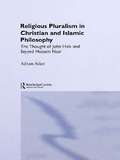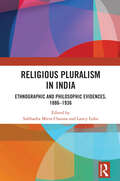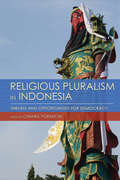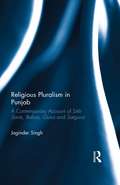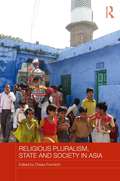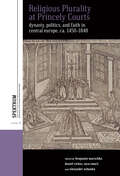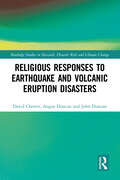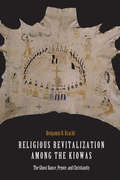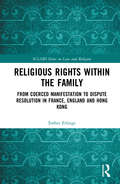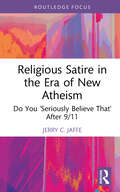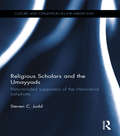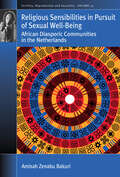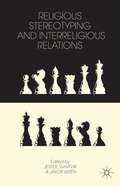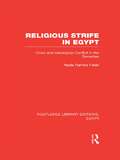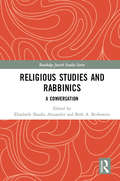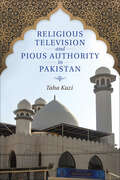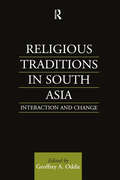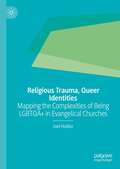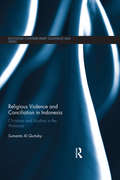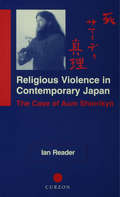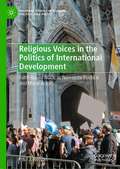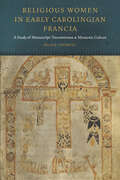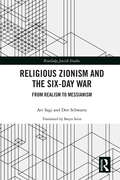- Table View
- List View
Religious Pluralism in Christian and Islamic Philosophy: The Thought of John Hick and Seyyed Hossein Nasr
by Adnan AslanThe philosophy of religion and theology are related to the culture in which they have developed. These disciplines provide a source of values and vision to the cultures of which they are part, while at the same time they are delimited and defined by their cultures.This book compares the ideas of two contemporary philosophers, John Hick and Seyyed Hossein Nasr, on the issues of religion, religions, the concept of the ultimate reality, and the notion of sacred knowledge.On a broader level, it compares two world-views: the one formed by Western Christian culture, which is religious in intention but secular in essence; the other Islamic, formed through the assimilation of traditional wisdom, which is turned against the norms of secular culture and is thus religious both in intention and essence.
Religious Pluralism in India: Ethnographic and Philosophic Evidences, 1886-1936
by Subhadra Mitra Channa Lancy LoboThis volume explores the inherent pluralism of Hinduism through ethnographic and philosophical evidence as presented in the Journal of Anthropological Society of Bombay. The essays dated 1886–1936 represent a period that marked the emergence of a European-educated native intelligentsia with a rationalist outlook. The chapters cover a wide range of topics from Tree Worship in Mohenjo Daro, the origin of the Hindu Trimurti, interpretation of Avestic and Vedic Texts, to the second set of more localized chapters that cover the Muhammadan Castes of Bengal, the Tenets and Practices of a Certain Class of Faqirs in Bengal, the Theoretical History of the Goddess Yellamma, and much more. Written during a particular historical as well as intellectual period that reflected certain key patterns – a period just following the Bengal Renaissance of the nineteenth century that ushered in the ideologies of a reformative Hinduism – this volume highlights how religions of all denominations have influenced each other and appear to have mingled beliefs and practices from multiple sources. It shows how tolerance and inclusiveness along with syncretism have been part of India’s religious and social history. This book will be of interest to students and researchers of religions, history, anthropology, sociology, political science, and sociology of religion. It will also be useful to those interested in inter-religious dialogues and civil society.
Religious Pluralism in Indonesia: Threats and Opportunities for Democracy (Cornell Modern Indonesia Project)
In 1945, Sukarno declared that the new Indonesian republic would be grounded on monotheism, while also insisting that the new nation would protect diverse religious practice. The essays in Religious Pluralism in Indonesia explore how the state, civil society groups, and individual Indonesians have experienced the attempted integration of minority and majority religious practices and faiths across the archipelagic state over the more than half century since Pancasila. The chapters in Religious Pluralism in Indonesia offer analyses of contemporary phenomena and events; the changing legal and social status of certain minority groups; inter-faith relations; and the role of Islam in Indonesia's foreign policy. Amidst infringements of human rights, officially recognized minorities—Protestants, Catholics, Hindus, Buddhists and Confucians—have had occasional success advocating for their rights through the Pancasila framework. Others, from Ahmadi and Shi'i groups to atheists and followers of new religious groups, have been left without safeguards, demonstrating the weakness of Indonesia's institutionalized "pluralism."Contributors: Lorraine Aragon, Christopher Duncan, Kikue Hamayotsu, Robert Hefner, James Hoesterey, Sidney Jones, Mona Lohanda, Michele Picard, Evi Sutrisno, Silvia Vignato
Religious Pluralism in Punjab: A Contemporary Account of Sikh Sants, Babas, Gurus and Satgurus
by Joginder SinghThis book analyses the heterogeneous modes of meditation, prayer, initiation, beliefs and practices, codes of conduct, ethics and life-style of the contemporary Sikh Sants, Babas, Gurus and Satgurus in Punjab.
Religious Pluralism, State and Society in Asia: Religious Pluralism, State And Society In Asia (Routledge Religion in Contemporary Asia Series)
by Chiara FormichiTaking a critical approach to the concept of ‘religious pluralism’, this book examines the dynamics of religious co-existence in Asia as they are directly addressed by governments, or indirectly managed by groups and individuals. It looks at the quality of relations that emerge in encounters among people of different religious traditions or among people who hold different visions within the same tradition. Chapters focus in particular on the places of everyday religious diversity in Asian societies in order to explore how religious groups have confronted new situations of religious diversity. The book goes on to explore the conditions under which active religious pluralism emerges (or not) from material contexts of diversity.
Religious Plurality at Princely Courts: Dynasty, Politics, and Confession in Central Europe, ca. 1555-1860 (Spektrum: Publications of the German Studies Association #30)
by Benjamin Marschke, Daniel Riches, Alexander Schunka, and Sara SmartEarly modern European monarchies legitimized their rule through dynasty and religion, and ideally the divine right of the ruler corresponded with the confession of the territory. It has thus been assumed that at princely courts only a single confession was present. However, the reality of the confessional circumstances at court commonly involved more than one faith. Religious Plurality at Princely Courts explores the reverberations of biconfessional or multiconfessional intra-Christian situations at courts on dynastic, symbolic, diplomatic, artistic, and theological levels, exploring interreligious dialogue, religious change, and confessional blending. Incorporating perspectives across European studies such as domestic and international politics, dynastic strategies, the history of ideas, women’s and gender history, as well as visual and material culture, the contributions to this volume highlight the dynamics and implications of religious plurality at court.
Religious Practice and Democracy in India
by Pradeep K. Chhibber Sandeep ShastriThis book demonstrates the close relationship between religion and democracy in India. Religious practice creates ties among citizens that can generate positive and democratic political outcomes. In pursuing this line of inquiry the book questions a dominant strand in some contemporary social sciences - that a religious denomination (Catholic, Hindu, Muslim, Sikh, and so on) is sufficient to explain the relationship between religion and politics or that religion and democracy are antithetical to each other. The book makes a strong case for studying religious practice and placing that practice in the panoply of other social practices and showing that religious practice is positively associated with democracy.
Religious Responses to Earthquake and Volcanic Eruption Disasters (Routledge Studies in Hazards, Disaster Risk and Climate Change)
by John Duncan Angus Duncan David ChesterThis book argues that, although secular and religious perspectives on disasters have often conflicted, today there are grounds for believing that the world’s major faiths have much to contribute to the processes of post-disaster recovery and future disaster risk reduction (DRR).It seeks to demonstrate how contemporary dialogues between theologians, disaster scholars and policymakers are defining new ways of working together. These explore how the resources of religious communities, e.g. buildings, human resources and finance, may be used to foster successful policies of DRR, particularly in the aftermath of earthquakes and volcanic eruptions. Musing on the relationships between religion and disasters has occurred for millennia and has affected many societies worldwide. In societies where the world’s major religions – Buddhism, Christianity, Hinduism, Islam, Judaism and Shinto – have been and remain dominant, attempting to find supernatural explanations for disasters has occurred throughout history and there have been many theologies seeking to explain why people suffer losses. It is argued that developments both within these traditions of faith and in how disasters are understood by the hazard research community of researchers and planners have allowed a new modus vivendi to emerge which emphasises both a recognition of religious worldviews by academic writers and disaster planners on the one hand, and a desire by people of faith and their leaders to be more fully committed to the goals of DRR.The book will appeal to those who are interested in the interface between disasters and theology across the principal religions of the world. This includes researchers and students in geology, geography, theology and religious studies. It will also be useful for specialist academic audience and the educated general reader.
Religious Revitalization among the Kiowas: The Ghost Dance, Peyote, and Christianity
by Benjamin R. KrachtFramed by theories of syncretism and revitalization, Religious Revitalization among the Kiowas examines changes in Kiowa belief and ritual in the final decades of the nineteenth century. During the height of the horse-and-bison culture, Kiowa beliefs were founded in the notion of daudau, a force permeating the universe that was accessible through vision quests. Following the end of the Southern Plains wars in 1875, the Kiowas were confined within the boundaries of the Kiowa-Comanche-Apache (Plains Apache) Reservation. As wards of the government, they witnessed the extinction of the bison herds, which led to the collapse of the Sun Dance by 1890. Though prophet movements in the 1880s had failed to restore the bison, other religions emerged to fill the void left by the loss of the Sun Dance. Kiowas now sought daudau through the Ghost Dance, Christianity, and the Peyote religion. Religious Revitalization among the Kiowas examines the historical and sociocultural conditions that spawned the new religions that arrived in Kiowa country at the end of the nineteenth century, as well as Native and non-Native reactions to them. A thorough examination of these sources reveals how resilient and adaptable the Kiowas were in the face of cultural genocide between 1883 and 1933. Although the prophet movements and the Ghost Dance were short-lived, Christianity and the Native American Church have persevered into the twenty-first century. Benjamin R. Kracht shows how Kiowa traditions and spirituality were amalgamated into the new religions, creating a distinctive Kiowa identity.
Religious Rights within the Family: From Coerced Manifestation to Dispute Resolution in France, England and Hong Kong (ICLARS Series on Law and Religion)
by Esther ErlingsIt is often asserted that ‘A family that prays together, stays together’. But what if a child no longer wishes to pray? This book analyses the law in relation to situations where parents force their children to manifest the parental religion. From thorough examination of international law it argues that, unlike what is generally believed, the human rights regime does not grant parents a right to impose manifestations of their religion on their children. Instead, the author proposes to regard coerced manifestations as a limitation on children’s right to freedom of manifestation, based on national laws that give parents rights at the domestic level under principles such as parental responsibility. The book focuses on two aspects of States’ positive obligations in this regard. First, the obligation to provide a regulatory framework that can protect children’s right to freedom of manifestation, and restricts limitations to those that are proportionate or 'necessary in a democratic society'. Second, to provide access to remedies, which it is argued should consist of access to a family-friendly infrastructure for dispute resolution available to parents and children in conflict over religious manifestation. Both depend heavily on the way States balance power between parents and children at the national level. The book includes three case studies and social research of jurisdictions that offer different perspectives under the principles of parental authority (France), parental responsibility (England) and parental rights (Hong Kong).
Religious Satire in the Era of New Atheism: Do You ‘Seriously Believe That’ After 9/11 (The Cultural Politics of Media and Popular Culture)
by Jerry C. JaffeReligious Satire in the Era of New Atheism presents a contemporary account of religious satire as evidenced by the modern art of stand-up comedy.Focused on the context of the post-9/11 American culture phenomenon, sometimes referred to as the New Atheism – as embodied by public intellectuals such as Christopher Hitchens, Sam Harris, and Richard Dawkins – it documents the rise of comedic satire in relation to evangelical beliefs and religious dogma. Drawing on the author’s own experience of stand-up performance, it examines the comedy of figures such as Mark Maron, Bill Maher, and Ricky Gervais and presents material from interviews with comedians including Lewis Black, John Fugelsang, and Leigh Ann Lord to provide unique insights into some of the issues and definitions surrounding satire.With attention to the demonstrable rise in religious satire following the events of September 11, 2001, the author considers the clear link between this increase and the New Atheist movement, exploring shared themes and presence at specific events, such that stand-up comedy represents the Avant Garde of the New Atheists.
Religious Scholars and the Umayyads: Piety-Minded Supporters of the Marwanid Caliphate (Culture and Civilization in the Middle East)
by Steven JuddReligious Scholars and the Umayyads analyzes legal and theological developments during the Marwānid period (64/684--132/750), focusing on religious scholars who supported the Umayyads. Their scholarly network extended across several generations and significantly influenced the development of the Islamic faith. Umayyad qādòīs, who represented the intersection of religious authority and imperial power, were particularly important. This book challenges the long-standing paradigm that the emerging Muslim faith was shaped by religious dissenters who were hostile to the Umayyads. A prosopographical analysis of Umayyad-era scholars demonstrates that piety and opposition were not necessarily synonymous. Reputable scholars served as qādòīs, tutors and advisors to Umayyad caliphs and governors. Their religious credentials were untarnished by their association with the Umayyads and they appear prominently in later hòadīth collections and fiqh works. This historiographical study demonstrates that excessive reliance on al-Tòabarī’s chronicle has distorted the image of the Umayyads. Alternatively, biographical sources produced by later hòadīth scholars reveal a rich tradition of Umayyad-era religious scholarship that undermines al-Tòabarī’s assumptions. Offering a better understanding of early Islamic religious development, this book is a valuable resource for students and researchers in the fields of Islamic history, Islamic legal studies and Arabic historiography.
Religious Sensibilities in Pursuit of Sexual Well-Being: African Diasporic Communities in the Netherlands (Fertility, Reproduction and Sexuality: Social and Cultural Perspectives #55)
by Amisah Zenabu BakuriThe self-identifying Ghanaian-Dutch and Somali-Dutch communities residing in the Randstad area of the Netherlands are deeply impacted by religious beliefs and cultural factors in their approach towards sexual health practices, well-being and pleasure. This book shows how religious sensibilities shape the physical activities, beauty practices, and gendered roles that are adopted into the daily lives of these communities in pursuit of their sexual and general well-being. Through an ethnographic account, it explores and challenges the assumptions held around the complex relationship between religion and sexuality.
Religious Stereotyping and Interreligious Relations
by Jesper Svartvik Jakob WirénReligion can heal, but it can hurt as well. This collection of essays addresses some key issues of religious stereotyping, prejudice, and discrimination, and considers a wide range of important topics which haunt our societies today. When stereotyping becomes the oxygen we inhale, when it is so important to us that we cannot see how we can survive without it - what can and should we do? Twenty-two scholars from Australia, Europe, the Middle East and North America explore the anatomy of various forms of stereotyping and ways to oppose them.
Religious Strife in Egypt: Crisis and Ideological Conflict in the Seventies (Routledge Library Editions: Egypt)
by Nadia Ramsis FarahThis critical analysis investigates the causes that brought about one of the most tumultuous periods in modern Egyptian history – the clashes between the Muslims and Copts during the 1970s. A unique retrospective, it features probing interviews with Egyptian intellectuals, writers, political and religious leaders, as well as common citizens from both the Muslim and Copt communities. Within a framework of economic, political and ideological factors, Nadia Ramsis Farah is able to synthesize a compelling portrait of a troubled national conscience in the face of religious strife. First published 1986.
Religious Studies and Rabbinics: A Conversation (Routledge Jewish Studies Series)
by Beth A. Berkowitz Elizabeth Shanks AlexanderReligious Studies and Rabbinics have overlapping yet distinct interests, subject matter, and methods. Religious Studies is committed to the study of religion writ large. It develops theories and methods intended to apply across religious traditions. Rabbinics, by contrast, is dedicated to a defined set of texts produced by the rabbinic movement of late antiquity. Religious Studies and Rabbinics represents the first sustained effort to create a conversation between these two academic fields. In one trajectory of argument, the book shows what is gained when each field sees how the other engages the same questions: When did the concept of "religion" arise? How should a scholar’s normative commitments interact with their scholarship? The book argues that if scholars from Religious Studies and Rabbinics do not realize they are addressing the same problems, they will not benefit from each other’s solutions. A second line of argument brings research methods, theoretical claims, and data associated with one field into contact with those of the other. When Religious Studies categories such as "ritual" or "the sacred" are applied to data from Rabbinics and, conversely, when text-reading strategies distinctive to Rabbinics are employed for texts from other traditions, both Religious Studies and Rabbinics enlarge their scope. The chapters range across such themes as ritual failure; rabbinic conceptions of scripture, ethics, food, time, and everyday life; problems of definition and normativity in the study of religion; J.Z. Smith’s writings; and the preaching of the African-American Christian evangelical social justice activist John Perkins. With chapters written by world-class theorists of Religious Studies and prominent text scholars of Rabbinics, the book provides a unique opportunity to expand the conceptual reach and scholarly audience of both Religious Studies and Jewish Studies.
Religious Television and Pious Authority in Pakistan
by Taha KaziIn Pakistan, religious talk shows emerged as a popular television genre following the 2002 media liberalization reforms. Since then, these shows have become important platforms where ideas about Islam and religious authority in Pakistan are developed and argued. In Religious Television and Pious Authority in Pakistan, Taha Kazi reveals how these talk shows mediate changes in power, belief, and practice. She also identifies the sacrifices and compromises that religious scholars feel compelled to make in order to ensure their presence on television. These scholars, of varying doctrinal and educational backgrounds—including madrasa-educated scholars and self-taught celebrity preachers—are given screen time to debate and issue religious edicts on the authenticity and contemporary application of Islamic concepts and practices. In response, viewers are sometimes allowed to call in live with questions. Kazi maintains that these featured debates inspire viewers to reevaluate the status of scholarly edicts, thereby fragmenting religious authority. By exploring how programming decisions inadvertently affect viewer engagements with Islam, Religious Television and Pious Authority in Pakistan looks beyond the revivalist impact of religious media and highlights the prominence of religious talk shows in disrupting expectations about faith.
Religious Tolerance from Renaissance to Enlightenment: Atheist’s Progress
by Eric MacPhailThis new study examines the relationship of atheism to religious tolerance from the Renaissance to the Enlightenment in a broad array of literary texts and political and religious controversies written in Latin and the vernacular primarily in France, the Netherlands, and Switzerland. The main authors featured are Desiderius Erasmus, Sebastian Castellio, Jean Bodin, Michel de Montaigne, Dirck Coornhert, Justus Lipsius, Gisbertus Voetius, the anonymous Theophrastus redivivus, and Pierre Bayle. These authors reflect and inform changing attitudes to religious tolerance inspired by a complete reconceptualization of atheism over the course of three centuries of literary and intellectual history. By integrating the history of tolerance in the history of atheism, Religious Tolerance from Renaissance to Enlightenment: Atheist’s Progress should prove stimulating to historians of philosophy as well as literary specialists and students of Reformation history.
Religious Traditions in South Asia: Interaction and Change
by Geoffrey A. OddieThese studies focus on questions of religious interaction and change in India from the sixth century B.C. to the present day. They represent the work of scholars in a range of disciplines and who are resident mostly in Australia
Religious Trauma, Queer Identities: Mapping the Complexities of Being LGBTQA+ in Evangelical Churches
by Joel HollierIn a polarised milieu that too often posits “queer” and “Christian” as competing realms, this book explores the complexities of identity development, religious traumatisation, and the task of creating safe faith spaces in which LGBTQA+ people can find healing, particularly in the Evangelical context. First, Joel Hollier examines the historical path of Evangelicalism, providing context for the current terrain of the “culture war” we find ourselves in. He then parses out experiences of gender/sexuality and religious/spiritual identity development, grounding them in an evolving theoretical base. Finally, Hollier offers a rounded critique of Evangelical church structures and mechanisms of trauma that hinder the healing process, along with potential sources of healing. Central to this work are the voices of LGBTQA+ people whose stories weave together a deeper understanding of the harms the Church has perpetrated, and the path forward.
Religious Violence and Conciliation in Indonesia: Christians and Muslims in the Moluccas (Routledge Contemporary Southeast Asia Series)
by Sumanto Al QurtubyMaluku in eastern Indonesia is the home to Muslims, Protestants, and Catholics who had for the most part been living peaceably since the sixteenth century. In 1999, brutal conflicts broke out between local Christians and Muslims, and escalated into large-scale communal violence once the Laskar Jihad, a Java-based armed jihadist Islamic paramilitary group, sent several thousand fighters to Maluku. As a result of this escalated violence, the previously stable Maluku became the site of devastating interreligious wars. This book focuses on the interreligious violence and conciliation in this region. It examines factors underlying the interreligious violence as well as those shaping post-conflict peace and citizenship in Maluku. The author shows that religion—both Islam and Christianity—was indeed central and played an ambiguous role in the conflict settings of Maluku, whether in preserving and aggravating the Christian-Muslim conflict or supporting or improving peace and reconciliation. Based on extensive ethnographic fieldwork and interviews as well as historical and comparative research on religious identities, this book is of interest to Indonesia specialists, as well as academics with an interest in anthropology, religious conflict, peace and conflict studies.
Religious Violence in Contemporary Japan: The Case of Aum Shinrikyo
by Ian ReaderThe Tokyo subway attack in March 1995 was just one of a series of criminal activities including murder, kidnapping, extortion, and the illegal manufacture of arms and drugs carried out by the Japanese new religious movement Aum Shinrikyo, under the guidance of its leader Asahara Shoko. Reader looks at Aum's claims about itself and asks, why did a religious movement ostensibly focussed on yoga, meditation, asceticism and the pursuit of enlightenment become involved in violent activities? Reader discusses Aum's spiritual roots, placing it in the context of contemporary Japanese religious patterns. Asahara's teaching are examined from his earliest public pronouncements through to his sermons at the time of the attack, and statements he has made in court. In analysing how Aum not only manufactured nerve gases but constructed its own internal doctrinal justifications for using them Reader focuses on the formation of what made all this possible: Aum's internal thought-world, and on how this was developed. Reader argues that despite the horrors of this particular case, Aum should not be seen as unique, nor as solely a political or criminal terror group. Rather it can best be analysed within the context of religious violence, as an extreme example of a religious movement that has created friction with the wider world that escalated into violence.
Religious Voices in the Politics of International Development: Faith-Based NGOs as Non-state Political and Moral Actors (Palgrave Studies in Religion, Politics, and Policy)
by Paul J. NelsonThis first study of faith-based development NGOs’ (FBOs) political roles focuses on how U.S. FBOs in international development educate and mobilize their constituencies. Most pursue cautious reformist agendas, but FBOs have sometimes played important roles in social movements. Nelson unpacks those political roles by examining the prominence of advocacy in the organizations, the issues they address and avoid, their transnational relationships, and their relationships with religious and secular social movements. The agencies that educate and mobilize U.S. constituencies most actively are associated with small Christian sects or with non-Christian minority faiths with historic commitments to activism or service. Specialized advocacy NGOs play important roles, and emerging movements on immigration and climate may represent fresh political energy. The book examines faith-based responses to the crises of climate change, COVID-19, and racial injustice, and argues that these will shape the future of religion as a moral and political force in America, and of NGOs in international development.
Religious Women in Early Carolingian Francia: A Study of Manuscript Transmission and Monastic Culture (Fordham Series in Medieval Studies)
by Felice LifshitzReligious Women in Early Carolingian Francia, a groundbreaking study of the intellectual and monastic culture of the Main Valley during the eighth century, looks closely at a group of manuscripts associated with some of the best-known personalities of the European Middle Ages, including Boniface of Mainz and his “beloved,”abbess Leoba of Tauberbischofsheim. This is the first study of these “Anglo-Saxon missionaries to Germany” to delve into the details of their lives by studying the manuscripts that were produced in their scriptoria and used in their communities. The author explores how one group of religious women helped to shape the culture of medieval Europe through the texts they wrote and copied, as well as through their editorial interventions.Using compelling manuscript evidence, she argues that the content of the women’s books was overwhelmingly gender-egalitarian and frequently feminist (i.e., resistant to patriarchal ideas). This intriguing book provides unprecedented glimpses into the “feminist consciousness” of the women’s and mixed-sex communities that flourished in the early Middle Ages.
Religious Zionism and the Six Day War: From Realism to Messianism (Routledge Jewish Studies Series)
by Avi Sagi Dov SchwartzThis book offers a new insight into the political, social, and religious conduct of religious-Zionism, whose consequences are evident in Israeli society today. Before the Six-Day War, religious-Zionism had limited its concern to the protection of specific religious interests, with its representatives having little share in the determination of Israel’s national agenda. Fifty years after it, religious-Zionism has turned into one of Israeli society’s dominant elements. The presence of this group in all aspects of Israel’s life and its members’ determination to set Israel’s social, cultural, and international agenda is indisputable. Delving into this dramatic transformation, the book depicts the Six-Day War as a constitutive event that indelibly changed the political and religious consciousness of religious-Zionists. The perception of real history that had guided this movement from its dawn was replaced by a "sacred history" approach that became an actual program of political activity. As part of a process that has unfolded over the last thirty years, the body and sexuality have also become a central concern in the movement’s practice, reflection, and discourse. The how and why of this shift in religious-Zionism – from passivity and a consciousness of marginality to the front lines of public life – is this book’s central concern. The book will be of interest to readers and scholars concerned with changing dynamic societies and with the study of religion and particularly with the relationship between religion and politics.
